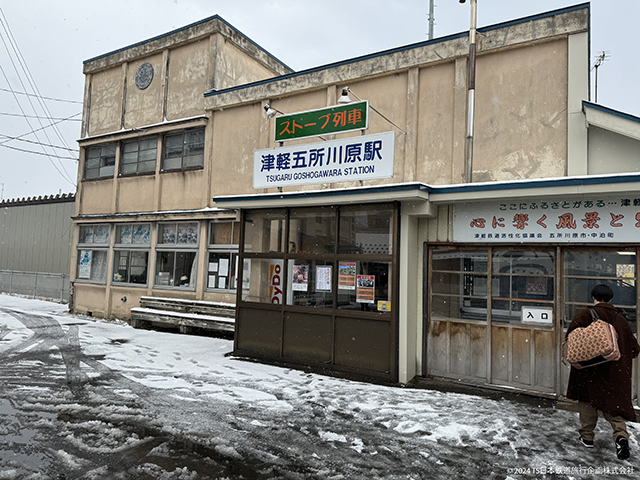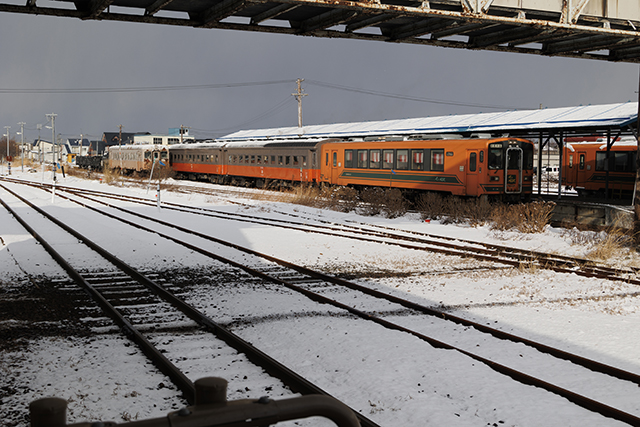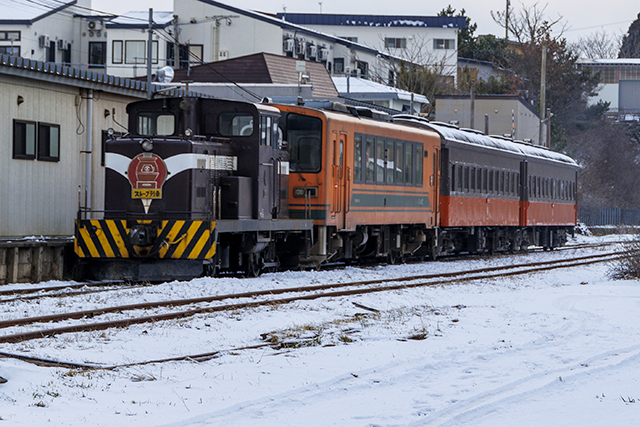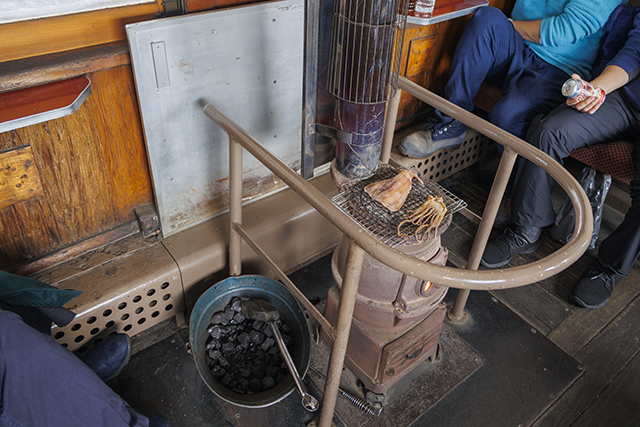The smell of squid being grilled permeates the Stove Train carriages. You can imagine what it was like travelling in former times…
The Tsugaru region in the northern area of Aomori Prefecture, and at the northern tip of Honshu it is famous for its severe winters characterized by heavy snowfall and frigid temperatures.
“The stove Train” is one of the winter symbols of the area and is often shown on Japanese TV.

In the past, coal stoves were used to keep trains warm in this region. These stoves not only provided warmth but also allowed passengers to heat their food.
The carriages on the Tsugaru Stove Train are old and unique as they still retain these stoves. As you travel on the Stove Train the aroma from the dried squid (イカ) being warmed on the stove as well as the heat permeates the carriage.
A journey back in time…
Most people catching the Stove Train, will arrive at the JR Gono Line Goshogawara station, which in itself is a very scenic line recommended by TS Japan Rail.
The Tsugaru Railway’s ticket office is next to the JR Station entrance, and as you can see from the below pictures it is a step back in time.



Both inside and out the station building has not changed. Even the timetable boardshows the train times using kanji numbers. There are no modern ticket machine. You will need to buy your tickets from the tick office, and these will be old style cardboard tickets, including the Stove Train supplement ticket.

The Stove Train ストーブ列車
The Stove train operates from 1st December to 31st March. It runs daily with several trips a day, except in December when it only operates on specific days.



Inside each of these carriages are two coal stoves. These stoves are original types that were used to heat trains.



As the stoves are open, they can and are used to heat up food. On the Tsugaru Railway Stove Train, passengers can buy dried squid, which the attendants on the train will then warm up on the stove.
The warmth from the stoves (even if you are not sitting right next to them), together with the smell of the Squid being cooked takes you back to long distance rail travel in years long gone, and is part of the experience of travelling on these trains.
[Note, there is also an ordinary diesel rail car attached to the train, this is for passengers who do not want to pay the Stove Train supplement fare, or do not like the smell of toasting dried squid].
Tsugaru Railway 津軽鉄道
The Tsugaru Railway (locally known as Tsutetsu) is a non JR Railway that operates one line that connects the city of Goshogawara and the town of Nakasato, a length of 20.7km. The first part of the line opened in 1928 and was completed in 1930. Up until 1984 the railway also carried freight from the forests in the area and connected to the Tsugaru Forest Railway until it closed in 1970.
The company’s early trains used coal stoves and the carriages used on this are original carriages with original stoves.
Tsugaru Railway website (Japanese only) https://tsutetsu.com/
Tsugaru Railway also has special trains operating at other times in the year
Travel Advice
Places of interest for tourists
Travelling on the Tsugaru Railway should be part of the itinerary for people travelling to Aomori (青森県)and Northern Tohoku (北東北) area.
Many Stove Train passengers travel to the town of Kanagi (金木)which takes 30 minutes from Goshogawara (津軽五所川原).
Kanagi is a historical town with quite a lot for tourists to see. For those who want to off the beaten track it might be a good place to stay.
For those who just want to enjoy the train ride and the scenery (which in winter will be a snowy landscape) then you can stay on the train to Tsugaru Nakasato (津軽中里)and catch the returning train (journey time 45 minutes each way).
Tourist Information (click on links):
Getting there
The Tsugaru Railway serves a fairly isolated area. Goshogawara can be reached via the JR Gono Line fairly quickly from Hirosaki (弘前) (direct trains) or Aomori (青森)/ Shin Aomori (新青森) by changing trains at Kawabe (川部). Passengers using the “Resort Shirakami” train from Aomori or Akita can change trains at Goshogawara. It should be noted that both JR Gono Line and Tsugaru Railway’s line are rural lines and trains are not so frequent so planning your trip is vital (as is the case if you are travelling around Tohoku). Of course for clients of TS Japan Rail we will do all the planning.
JR Rail Pass
Tsugaru Railway is not part of the JR network so the all Japan JR Rail Passes are not valid on the Tsugaru Railway and it is not one of the non JR railways included in the regional JR Rail Passes covering the area. However the fare is fairly inexpensive (Y1,370 to do the whole line each way on the Stove Train, Y870 on ordinary trains)
For Rail Enthusiasts

An interesting aspect of the Tsugaru Railway is the vintage passenger train carriages and also freight cars at Goshogawara station. The railway also has a Russell Snow Plough (as the area has heavy snow fall)
Ordinary trains are operated by diesel cars of which the company has five (designated at Tsugaru KiHa 21 series).
A certain amount of planning is required to include this train / railway in your travel plans, TS Japan Rail can of course help!

Whether you want to See Japan by Rail or Explore Japan’s Railways, TS Japan Rail can help you plan your trip with ideas, designing travel itineraries, assisting with bookings and more.
We take the stress out of planning your trip and help ensure it is successful!

For more information on our services
see our homepage!










コメント
コメント一覧 (2)
Hi, I would like to ride the stove train on 15 February. May I know timetable available for stove train. I’m coming from Morioka. Arigato
Thank you for reading the article. There are only three Stove Train services a day. 9:35, 12:00 & 14:40. The 9:35 is too early if you are travelling from Morioka, but the 12:00 can be easily caught, and the 14:40 is possible but not so convenient as there is a long wait at Goshogawara. for the 12:00 service you need to catch the Hayabusa no 1 shinkansen from Morioka at 8:50 to Shin Aomori. At Shin Aomori change to the Ou Main Line departing at 9:58 (you have 8 mins to change trains) for Hirosaki. you need to change at Kawabe (train arrives at 10:29, cross footbridge to Gono Line platform) and catch the 10:39 Gono Line train getting off at Goshogawara (11:05).From Morioka to Goshogawara is all JR so if have a JR Rail Pass you can use this. If not you should purchase a through ticket from the JR ticket office. At Goshogawara you need to exit the JR Station and go to the Tsugaru Tetsudo station next door and purchase tickets for the Stove Train there. To catch the 14:40 service you need to get the 10:59 shinkansen from Morioka (Hayabusa 9) to Shin Aomori (11:51) change to the 12:20 Ou Line Train (heading for Hirosaki) and change at Kawabe (arrive 12:50) to the JR Gono Line (dept 12:56) and arrive at Goshogawara at 13:24, however you will have a wait to 14:40 for the Stove train (you could catch an ordinary train one way and travel on the Stove Train coming back). It sounds complicated but it is actually very easy. Most tourist passengers get off at Kanagi but you can go to Tsuruga Nakasato, (end of the line) and return back on the Stove Train. Fare if you are not using a JR Rail Pass is Morioka to Goshogawara Fare Y4,070 + shinkansen ticket (Morioka to Shin Aomori) Y2,970, Tsugaru Tetsudo Goshogawara to Tsugaru Nakasato Y870 +Y500 supplement for the Stove Train. We hope that this helps you.